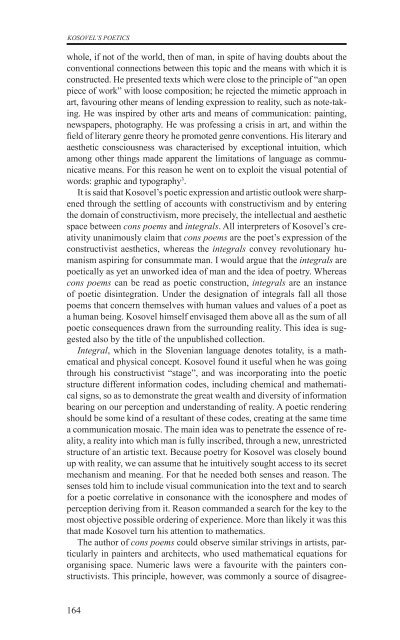razprave (pdf) - Društvo za primerjalno književnost - ZRC SAZU
razprave (pdf) - Društvo za primerjalno književnost - ZRC SAZU
razprave (pdf) - Društvo za primerjalno književnost - ZRC SAZU
- No tags were found...
You also want an ePaper? Increase the reach of your titles
YUMPU automatically turns print PDFs into web optimized ePapers that Google loves.
KOSOVEL’s poeticswhole, if not of the world, then of man, in spite of having doubts about theconventional connections between this topic and the means with which it isconstructed. He presented texts which were close to the principle of “an openpiece of work” with loose composition; he rejected the mimetic approach inart, favouring other means of lending expression to reality, such as note-taking.He was inspired by other arts and means of communication: painting,newspapers, photography. He was professing a crisis in art, and within thefield of literary genre theory he promoted genre conventions. His literary andaesthetic consciousness was characterised by exceptional intuition, whichamong other things made apparent the limitations of language as communicativemeans. For this reason he went on to exploit the visual potential ofwords: graphic and typography 3 .It is said that Kosovel’s poetic expression and artistic outlook were sharpenedthrough the settling of accounts with constructivism and by enteringthe domain of constructivism, more precisely, the intellectual and aestheticspace between cons poems and integrals. All interpreters of Kosovel’s creativityunanimously claim that cons poems are the poet’s expression of theconstructivist aesthetics, whereas the integrals convey revolutionary humanismaspiring for consummate man. I would argue that the integrals arepoetically as yet an unworked idea of man and the idea of poetry. Whereascons poems can be read as poetic construction, integrals are an instanceof poetic disintegration. Under the designation of integrals fall all thosepoems that concern themselves with human values and values of a poet asa human being. Kosovel himself envisaged them above all as the sum of allpoetic consequences drawn from the surrounding reality. This idea is suggestedalso by the title of the unpublished collection.Integral, which in the Slovenian language denotes totality, is a mathematicaland physical concept. Kosovel found it useful when he was goingthrough his constructivist “stage”, and was incorporating into the poeticstructure different information codes, including chemical and mathematicalsigns, so as to demonstrate the great wealth and diversity of informationbearing on our perception and understanding of reality. A poetic renderingshould be some kind of a resultant of these codes, creating at the same timea communication mosaic. The main idea was to penetrate the essence of reality,a reality into which man is fully inscribed, through a new, unrestrictedstructure of an artistic text. Because poetry for Kosovel was closely boundup with reality, we can assume that he intuitively sought access to its secretmechanism and meaning. For that he needed both senses and reason. Thesenses told him to include visual communication into the text and to searchfor a poetic correlative in consonance with the iconosphere and modes ofperception deriving from it. Reason commanded a search for the key to themost objective possible ordering of experience. More than likely it was thisthat made Kosovel turn his attention to mathematics.The author of cons poems could observe similar strivings in artists, particularlyin painters and architects, who used mathematical equations fororganising space. Numeric laws were a favourite with the painters constructivists.This principle, however, was commonly a source of disagree-164
















